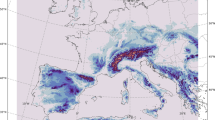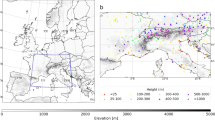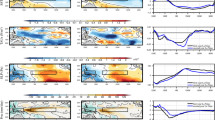Summary
The numerical simulation of a long-lived, stationary mesoscale convective system (MCS) already described in a previous paper (Fernández et al., 1995) is analyzed in greater detail. The influence of various external forcings, such as sea surface temperature, local orography or terrain roughness, upon the characteristics of the system is studied. This analysis makes it possible not only to identify the most important factors, but also to deduce the importance of some other internal forcings and to propose explanations for some dynamic features of the system that were difficult to understand. Hence, the sensitivity test methodology applied seems to be a useful tool to clarify the complex dynamics of some moist convective events. In the modelled MCS, sea surface temperature and orography are identified as key factors. The results also indicate that the upstream triggering of convection provoked by an orographic blocking effect is the main cause of the development of the system, while upslope triggering plays a secondary role.
Similar content being viewed by others
References
Anthes, R. A., Hsie, E.-Y., Kuo, Y.-H., 1987: Description of the Penn State/NCAR Mesoscale Model Version 4 (MM4). NCAR Tech. Note 282, NCAR, Boulder, CO.
Bleeker, W., Andre, M. J., 1951: On the diurnal variation of precipitation, particularly over central U.S.A., and its relation to large-scale orographic circulation systems.Quart. J. Roy. Meteor. Soc.,77, 260–271.
Chappell, C. F., 1986: Quasi-stationary convective events. In: Ray, P. S., (ed.)Mesoscale Meteorology and Forecasting. Boston: A.M.S., pp. 289–310.
Chen, S. S., Frank, W. M., 1993: A numerical study of the genesis of extratropical convective mesovortices. Part I: Evolution and dynamics.J. Atmos. Sci.,50, 2401–2426.
Fernández, C., Gaertner, M. A., Gallardo, C., Castro, M., 1995: Simulation of a long-lived meso-β scale convective system over the mediterranean coast of Spain. Part I: Numerical predictability.Meteorol. Atmos. Phys.,56, 157–179.
Fritsch, J. M., Chappell, C. F., 1980a: Numerical prediction of convectively driven mesoscale pressure systems. Part I: Convective parameterization.J. Atmos. Sci.,37, 1722–1733.
Fritsch, J. M., Chappell, C. F., 1980b: Numerical prediction of convectively driven mesoscale pressure systems. Part II: Mesoscale model.J. Atmos. Sci.,37, 1734–1762.
Gaertner, M. A., Castro, M., 1996: A new method for vertical interpolation of the mass field.Mon. Wea. Rev.,124, 1596–1603.
Gaertner, M. A., Fernández, C., Castro, M., 1993: A two-dimensional simulation of the Iberian summer thermal low.Mon. Wea. Rev.,121, 2740–2756.
Gutman, L. N., Melgarejo, J. W., 1981: On the laws of geostrophic drag and heat transfer over a slightly inclined terrain,J. Atmos. Sci.,38, 1714–1724.
Houze, R. A., 1993:Cloud Dynamics. (International Geophysics Series, Vol. 53): Academic Press.
Hsie, E.-Y., Anthes, R. A., Keyser, D., 1984: Numerical simulation of frontogenesis in a moist atmosphere.J. Atmos. Sci.,41, 2581–2594.
Johnson, R. H., 1976: The role of convective-scale precipitation downdrafts in cumulus and synoptic-scale interactions.J. Atmos. Sci.,33, 1890–1910.
Kaplan, M. L., Zack, J. W., Wong, V. C., Coats, G. D., 1984: The interactive role of subsynoptic scale jet streak and planetary boundary layer processes in organizing an isolated convective complex.Mon. Wea. Rev.,112, 2212–2238.
Keyser, D., Uccellini, L. W., 1987: Regional models: emerging research tools for synoptic meteorologists.Bull. Amer. Meteor. Soc.,68, 306–320.
Kreitzberg, C. W., Perkey, D. J., 1976: Release of potential instability: Part I. A sequential plume model within a hydrostatic primitive equation model.J. Atmos. Sci.,33, 456–475.
Lott, F., 1994: The significance of sub-grid scale orography and problems in their representation in GCM's.ECMWF Seminar Proceedings on Parameterization of sub-grid scale physical processes. ECMWF, Reading, 277–303.
Mailhot, J., Chouinard, C., 1989: Numerical forecasts of explosive winter storms: Sensitivity experiments with a meso-α scale model.Mon. Wea. Rev.,117, 1311–1343.
Mason, P. J., 1988: The formation of areally-averaged roughness lengths.Quart. J. Roy. Meteor. Soc.,114, 399–420.
Mason, P. J., 1991: Boundary-layer parameterization in heterogeneous terrain.Proceedings of ECMWF workshop on fine-scale modelling and the development of parameterization schemes. ECMWF, Reading, 199–227.
Miller, M. J., Palmer, T. N., Swinbank, R., 1989: Parametrization and influence of subgridscale orography in general circulation and numerical weather prediction models.Meteorol. Atmos. Phys.,40, 84–109.
Molinari, J., Dudek, M., 1992: Parameterization of convective precipitation in mesoscale numerical models: A critical review.Mon. Wea. Rev.,120, 326–344.
McAnelly, R. L., Cotton, W. R., 1992: Early growth of mesoscale convective complexes: a meso-β-scale cycle of convective precipitation?.Mon. Wea. Rev.,120, 1851–1877.
Reinking, R. F., Boatman, J. F., 1986: Upslope precipitation events. In: Ray P. S., (ed.)Mesoscale Meteorology and Forecasting. Boston: A. M. S., pp. 437–471.
Richard, E., Mascart, P., Nickerson, E. C., 1989: The role of surface friction in downslope windstorms.J. Appl. Meteor.,28, 241–251.
Riosalido, R., Rivera, A., Martín, F., 1989: Desarrollo de un sistema convectivo de mesoescala durante la campaña PREVIMET MEDITERRANEO-87.Primer Simposio Nacional de Predictores del INM, 67–84.
Rotunno, R., Klemp, J. B., 1982: The influence of the shearinduced pressure gradient on thunderstorm motion.Mon. Wea. Rev.,110, 136–151.
Seitter, K. L., Kuo, H.-L., 1983: The dynamical structure of squall-line type thunderstorms.J. Atmos. Sci.,40, 2831–2854.
Stein, U., Alpert, P., 1993: Factor separation in numerical simulations.J. Atmos. Sci.,50, 2107–2115.
Tucker, D. F., Reiter, E. R., 1988: Modeling heavy precipitation in complex terrain.Meteorol. Atmos. Phys.,39, 119–131.
Uccellini, L. W., Petersen, R. A., Brill, K. F., Kocin, P. J., Tuccillo, J. J., 1987: Synergistic interactions between an upper-level jet streak and diabatic processes that influence the development of a low-level jet and a secondary coastal cyclone.Mon. Wea. Rev.,115, 2227–2261.
Zhang, D.-L., Fritsch, J. M., 1987: Numerical simulation of the meso-β-scale structure and evolution of the 1977 Johnstown Flood. Part II: Inertially stable warm-core vortex and the mesoscale convective complex.J. Atmos. Sci.,44, 2593–2612.
Zhang, D.-L., Fritsch, J. M., 1988: A numerical investigation of a convectively generated, inertially stable, extratropical warm-core mesovortex over land. Part I: Structure and evolution.Mon. Wea. Rev.,116, 2660–2687.
Zhang, D.-L., Gao, K., Parsons, D. B., 1989: Numerical simulation of an intense squall line during 10–11 June 1985 PRE-STORM. Part I: Model verification.Mon. Wea. Rev.,117, 960–994.
Author information
Authors and Affiliations
Additional information
With 18 Figures
Rights and permissions
About this article
Cite this article
Fernández, C., Gaertner, M.A., Gallardo, C. et al. Simulation of a long-lived meso-β scale convective system over the mediterranean coast of Spain. Part II: Sensitivity to external forcings. Meteorl. Atmos. Phys. 62, 179–200 (1997). https://doi.org/10.1007/BF01029701
Received:
Revised:
Issue Date:
DOI: https://doi.org/10.1007/BF01029701




